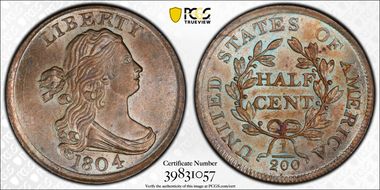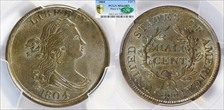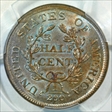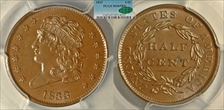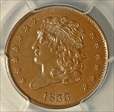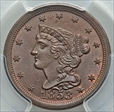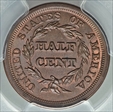MrMitosis 的钱币相册
CAC Approved. Plain 4, no stems. In 1804 12 varieties were produced from 5 obverse and 6 reverse dies. The plain 4/no stems variety was coined from a single die pair (Cohen 13; Obverse 5/Reverse G). Uncirculated examples are scarce but are the most common 1804 half cent variety. Brown Mint State examples, like mine, are the easiest to find. The strike and luster on my example are phenomenal--and it was worth every one of the many pennies I paid for it.
CAC Approved. Plain 4, no stems. In 1804 12 varieties were produced from 5 obverse and 6 reverse dies. The plain 4/no stems variety was coined from a single die pair (Cohen 13; Obverse 5/Reverse G). Uncirculated examples are scarce but are the most common 1804 half cent variety. Brown Mint State examples, like mine, are the easiest to find. The strike and luster on my example are phenomenal--and it was worth every one of the many pennies I paid for it.
CAC Approved. Plain 4, no stems. In 1804 12 varieties were produced from 5 obverse and 6 reverse dies. The plain 4/no stems variety was coined from a single die pair (Cohen 13; Obverse 5/Reverse G). Uncirculated examples are scarce but are the most common 1804 half cent variety. Brown Mint State examples, like mine, are the easiest to find. The strike and luster on my example are phenomenal--and it was worth every one of the many pennies I paid for it.
CAC Approved. Plain 4, no stems. In 1804 12 varieties were produced from 5 obverse and 6 reverse dies. The plain 4/no stems variety was coined from a single die pair (Cohen 13; Obverse 5/Reverse G). Uncirculated examples are scarce but are the most common 1804 half cent variety. Brown Mint State examples, like mine, are the easiest to find. The strike and luster on my example are phenomenal--and it was worth every one of the many pennies I paid for it.
CAC Approved. Had is crossed from a NGC into a PCG slab. Great cartwheel luster, clean fields, even toning, solid strike! EAC MS62. Looks to be Breen's State VI to VII (with prominent clash marks within the wreath on the reverse.
CAC Approved. Had is crossed from a NGC into a PCG slab. Great cartwheel luster, clean fields, even toning, solid strike! EAC MS62. Looks to be Breen's State VI to VII (with prominent clash marks within the wreath on the reverse.
CAC Approved. Had is crossed from a NGC into a PCG slab. Great cartwheel luster, clean fields, even toning, solid strike! EAC MS62. Looks to be Breen's State VI to VII (with prominent clash marks within the wreath on the reverse.
129,694 minted and CAC approved. None grade better in any color. DS-1.0. A sharply struck even medium brown Uber-GEM type representative with some red in the devices. The satiny surfaces show only minor imperfections.
129,694 minted and CAC approved. None grade better in any color. DS-1.0. A sharply struck even medium brown Uber-GEM type representative with some red in the devices. The satiny surfaces show only minor imperfections.
129,694 minted and CAC approved. None grade better in any color. DS-1.0. A sharply struck even medium brown Uber-GEM type representative with some red in the devices. The satiny surfaces show only minor imperfections.




















